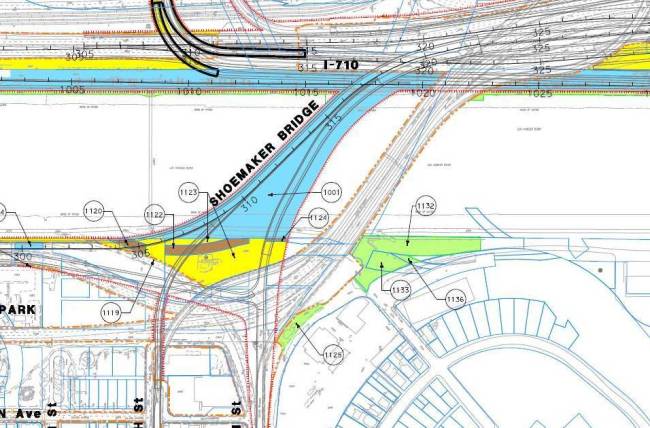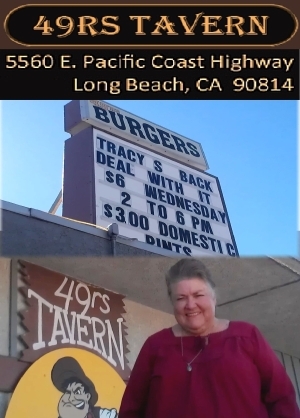|
Shoemaker Bridge Reuse As Park Intriguing, But Can And Should Avoid Potentially Costly Pitfall
|
 |
 |  |
|
Shoemaker Bridge Reuse As Park Intriguing, But Can And Should Avoid Potentially Costly Pitfall
|
 |
 |  |
| (June 3, 2013, 1:35 p.m.) -- A major problem with turning all or part of the soon-to-be former Shoemaker Bridge (connecting downtown Long Beach with the 710 freeway) into a park is that unlike High Line Park in NYC and adaptive resues of former railroad bridges elsewhere, it's not a railroad bridge over a street. The Shoemaker Bridge is over the Los Angeles River which (for better or worse after concrete channelization decades ago) is now the key artery in the Corps of Engineers Los Angeles County Drainage Area flood control system.  Image source: CalTrans 710 EIR The L.A. River, a federally declared floodway, handles the runoff from a vast area stretching from the San Fernando Valley through Los Angeles and southeast L.A. County. The flow reaches its maximum capacity in Long Beach...near the Shoemaker Bridge. Although we are among those who favor treating the L.A. River more as a natural asset, we respect its current real-world functions which are (1) to protect mainly Long Beach and southeast L.A. County residents from flooding; and (2) to protect homeowners and commercial property owners from predatory "flood insurance" and crippling building and development restrictions that the Federal Emergency Management Agency (FEMA) can impose when it decrees a flood control system doesn't provide greater than "100 year" (0.01 annual chance) flood protection. KCET's award winning So Cal Connected documented FEMA's abusive flood insurance practices elsewhere (series titled: "Hung Out to Dry"). Long Beach and southeast L.A. County residents experienced it firsthand on the mid-1990s and into the early 2000s after the Corps of Engineers postulated, and FEMA decreed, that the L.A. River couldn't handle a "100 year" flow. As a result, for several years Long Beach homeowners and commercial property owners (some miles away from the L.A. River) had to pay costly "flood insurance" premiums each year (they're roughly twice as much now). This continued until Congress funded a Corps of Engineers project (not easily funded today) that raised the L.A. River levees to increase the channel's capacity. Last year, Caltrans' I-710 draft EIR/EIS proposed putting new obstructions in the L.A. River channel (newly configured bridges, interchanges, etc.) and offset square footage lost with the new obstructions against square footage gained by removing items like the old Shoemaker Bridge. Based on those numbers, Caltrans (and a Caltrans hired hydrology firm) claimed there'd be no significant impact. In response, the Corps of Engineers sent a sternly worded EIR response stating that Caltrans hasn't demonstrated to COE's satisfaction at this point that the proposed new obstructions won't significantly change or reduce the channel's flood conveyance capacity. Wrigley area homeowners who were impacted by the flood insurance requirements criticized the Caltrans EIR. So did LBREPORT.com editorially. Caltrans has cited a number of reasons for now reworking portions of its I-710 EIR/EIS. The bottom line: the last thing that any thoughtful Long Beach resident should support is leaving parts of the old Shoemaker Bridge in the L.A. River alongside the new bridge. It will make matters worse. It will decrease the L.A. River square footage capacity below what has been proposed by Caltrans. It will make the 710's EIR/EIS mathematical assertions on reduced L.A. River square footage capacity no longer valid. The Corps of Engineers has already indicated publicly that it does NOT accept Caltrans' assurances. Going even further than what Caltrans has proposed invites FEMA to trigger the costly flood insurance and building restrictions on taxpaying homeowners and businesses that the City of Long Beach and local elected officials at the County and federal level have sought to avoid. We remain intrigued with the idea of adaptively reusing part of the old Shoemaker Bridge up to the river's edge and linking to Drake Park and elsewhere. However, the only way to ensure that this won't reduce the L.A. River's square footage capacity is to remove portions of the old bridge from the River. This won't prevent the park but it will prevent costly unintended consequences. Vice Mayor Robert Garcia's agendizing memo is vague on this matter, but taxpaying Long Beach homeowners and commercial property owners deserve protection from, not potential exposure to, additional costs. The Corps of Engineers isn't willing simply to accept assurances of some paid consultant and neither should Long Beach taxpayers, especially on matters affecting life and property. LBREPORT.com urges the Council to allow management to pursue the feasibility of a Shoemaker Bridge reuse project to the extent it doesn't leave portions of the soon-to-be-former Shoemaker bridge within the L.A. River channel.
Contact us: mail@LBReport.com |
           Hardwood Floor Specialists Call (562) 422-2800 or (714) 836-7050  |
Contact us: mail@LBReport.com